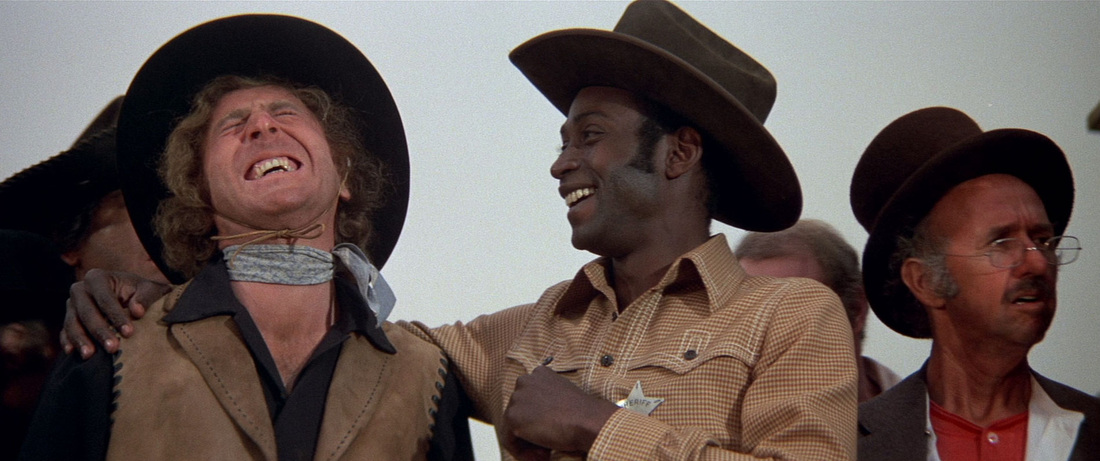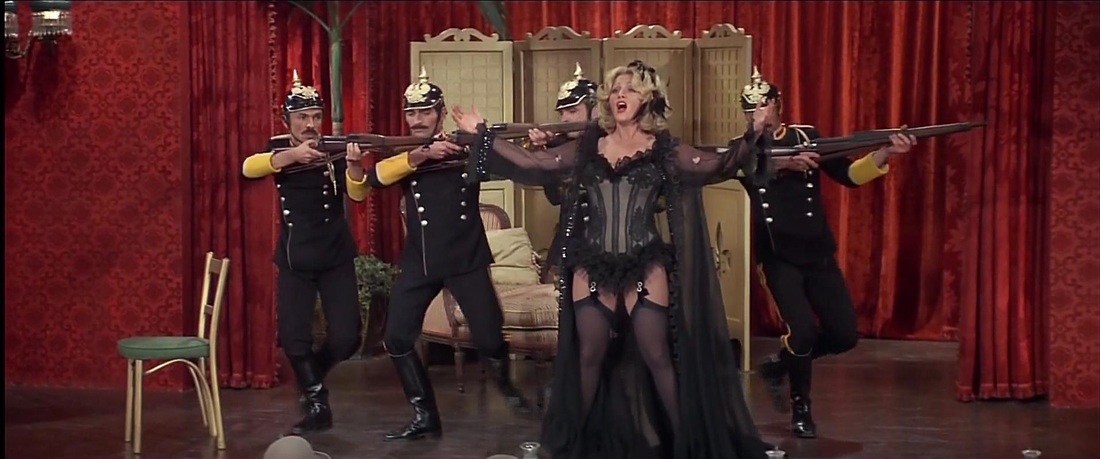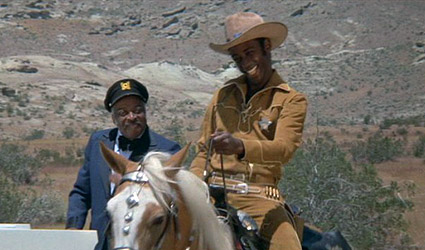n
Going to drive in movies was the stuff of family outings growing up. I have many memories of piling into the back of the family station wagon (a ’63 VW micro bus to be precise) with all four and eventually five siblings to see the likes of murky classics such as Guns of Navarone, Shane, the first several James Bond movies, and various Disney offerings of the ‘60’s and early ‘70’s. It’s also worth noting that in my post-pubescent years drive ins would again prove formative by providing a venue for dating and various early forays into mating rituals. I will say no more.
As for Blazing Saddles, I watched it with two friends, and it was the funniest, most outrageous movie I had ever seen. It’s hard to believe that the movie turned 40 this past February. The movie stars Cleavon Little and Gene Wilder in the lead roles with Brooks himself appearing in multiple supporting parts including Governor William J. Le Petomane and a Yiddish-speaking Indian chief. The cast also includes Slim Pickens, Alex Karras, and David Huddleston as well as Brooks movie regulars, Dom DeLuise, Madeline Kahn, and Harvey Korman. The truly outrageous script was written by a team consisting of Brooks, Andrew Bergman, Richard Pryor, Norman Steinberg, and Al Uger.
What I still enjoy about the movie to this day, is the several moments in the film where Brooks manipulates the “fourth wall,” a technique from dramatic arts. If not familiar, the fourth wall is that imaginary “wall” at the front of the stage in traditional theater. The audience views the action in the play through this so-called wall with the characters on stage having no direct contact with them. But when the actors speak directly to the audience or acknowledge their presence, it’s called “breaking the fourth wall,” and Brooks does so repeatedly throughout the movie. Exhibit “A” is Harvey Korman’s character Hedley Lamarr droning on in soliloquy, evilly plotting the downfall the town of Rock Ridge. Eventually, he turns directly to the camera and says, “Why am I asking you?” It’s really at the end of the movie during the big fight scene, when the plot falls completely apart with the cast ending up brawling on the streets of then contemporary Burbank outside the Warner Brothers studio. In the finale, the main characters then meet up at Mann’s Oriental Theater for the decisive good guy/bad guy show down. Afterwards, Little and Wilders go back inside the theater to watch themselves in the end of the premiere of what is the finished movie, as they ride off into the sunset not on horseback—but in a chauffeured limousine.
Other favorite “movie” moments in Blazing Saddles? Too many to mention, but Mongo riding into Rock Ridge bareback on a Brahma bull and then punching out a horse comes to mind, along with Lili von Shtup’s spirited rendition of the song “I’m Tired,” accompanied by a chorus of strapping young lads resplendent in WWI German military outfits complete with Kaiser helmets and rifles. As a musician, perhaps my favorite moment in the movie has no dialogue at all; it simply follows the newly minted sheriff Bart (Cleavon Little) bedecked in Gucci, on his way to Rock Ridge with Count Basie’s “April in Paris” playing in the background. As we watch, sheriff Bart riding on a beautiful palomino through the scrub, the camera shifts to show Basie and his band set up and actually playing the song in the mesquite panorama. Little then rides over to Basie and they high-five. Brilliant!
Memory two: a few years later and Maria was now a sophomore at San Francisco State. One of her classes was—and this is definitely San Francisco—human sexuality. Her class that morning focused on the LGBT community and a transgender had spoken to the students. She told me that she didn’t get why one’s sexual orientation was a big deal, and how she didn’t understand why some people couldn’t accept the fact that others were different. I reminded her of the time we watched Blazing Saddles and asked her to remember the scene where all the townsfolk of Rock Ridge met the railroad workers in the middle of the night to build an exact replica of the town to fool the bad guys. I said, “Remember when the mayor wasn’t going to let everyone in on the deal?” She thought for a moment and then said, “Yeah, you’re right. Even the Irish.”
Like all great comedies, Blazing Saddles is a movie filled with brilliant lines. Hidden among this vast field of comic gems are huge social themes/issues and life lessons. Inadvertent? I’d like to think it was completely intentional on the part of Brooks’ and the other writers. If I somehow ever get the chance to meet him, I will ask exactly that. Here are some of my favorite lines from the movie and the lessons I learned from them.
1. Lili von Shtup: “A wed wose. How womantic.”
Lesson: never underestimate the power of giving a woman flowers.
2. Mexican Bandit: “Badges? We don’t need no stinking badges.”
Lesson: sometimes expertise needs no certification.
3. Mongo: “Mongo only pawn in game of life.”
Lesson: this has got to be one of the most profound quotes from western civilization in the last half-century. I’ve used this line more than any other from the movie; for months on end it was the tag line on my Outlook signature. The lesson? In short, I’m only a cog in the enormous universal machine.
4. Jim: What did you expect? “Welcome, sonny?” “Make yourself at home?” “Marry my daughter?” You’ve got to remember that these are just simple farmers. These are people of the land. The common clay of the new West. You know… morons.”
Lesson: even our best laid plans (sorry) can sometimes go awry, and it’s probably not a good move to place your expectations too high when trying something new for the first time.
5. Bart: “Well Jim, since you are my guest and I am your host, what are your pleasures. What do you like to do?”
Jim: “Oh, I don’t know. Play chess…screw.”
Bart: “Well let’s play chess.”
Lesson: it’s always good to have more than one activity to share with new friends.
6. Bart: “No, thank you. Fifteen is my limit on schnitzengruben.”
Lesson: this is another version of the Dirty Harry line, “A man’s got to know his limitations.” Just as true and wise here, because too many schnitzengruben can really wipe you out.
7. Hedley Lamarr: “Men, you are about to embark on a great crusade to stamp out runaway decency in the west. Now you men will only be risking your lives, whilst I will be risking an almost certain Academy Award nomination for Best Supporting Actor.”
Lesson: why is it that psychopaths are always at the top running things?
8. Olson Johnson: “Aw, prairie sh*t… Everybody!”
Lesson: to me this is the central theme of Blazing Saddles as in, “everybody gets a chance.”
9. (Bart is bidding farewell to the people of Rock Ridge) Bart: “My work here is done. I’m needed elsewhere now. I’m needed wherever outlaws rule the West, wherever innocent women and children are afraid to walk the streets, wherever a man cannot live in simple dignity, wherever a people cry out for justice.”
Crowd: [in unison] “BULLSH*T!”
Bart: “All right, you caught me. To speak the plain truth, it’s getting pretty damn dull around here.”
Lesson: don’t BS your friends. They’ll know it immediately.
10. Governor William J. Le Petomane: “Holy underwear! Sheriff murdered! Innocent women and children blown to bits! We have to protect our phoney baloney jobs here, gentlemen! We must do something about this immediately! Immediately! Immediately! Harrumph! Harrumph! Harrumph!”
Lesson: there’s really nothing else you ever need to know about American politics.
11. Jim: [to Bart] “What’s a dazzling urbanite like you doing in a rustic setting like this?”
Lesson: other than Mongo’s remark about being a pawn in the game of life this to me is the most brilliant line in the move. The lesson? It always helps to pay a compliment to someone you’re meeting for the first time to break the ice.
12. Reverend Johnson: [praying] “O Lord, do we have the strength to carry off this mighty task in one night? Or are we just jerking off?”
Townspeople: “Amen.”
Lesson: the ultimate reality check—this question should be asked before making any important life decision.
13. Hedley Lamarr: “Now go do… that voodoo… that YOU DO… SO WELL…!”
Lesson: a compliment can really help build a sense of team work when embarking on a new big project.
14. Bart: “Excuse me while I whip this out…”
Lesson: always carefully preface any sudden social indiscretions.
nn


